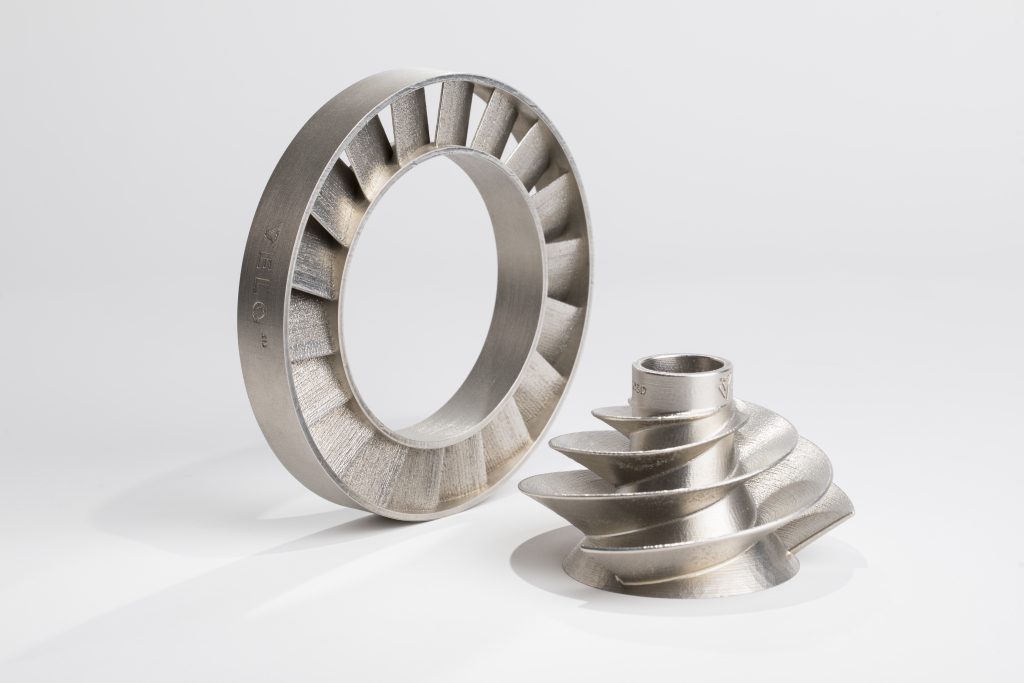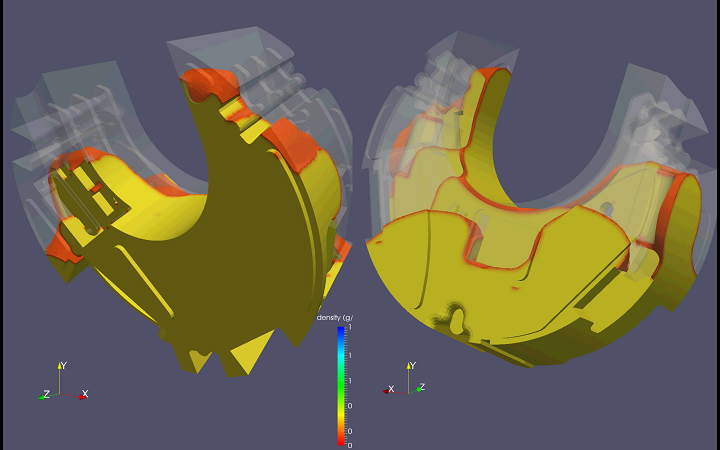Honeywell and SLM Solutions qualify parameters for 3D printing thicker aluminum aerospace parts
VELO3D and Honeywell to qualify Sappire 3D printer for aerospace
Honeywell Aerospace to Qualify VELO3D’s Metal 3D Printing for End Use Parts
The entire aerospace industry has sensed the manufacturing sea change and is integrating 3D printing into production wherever it provides value. Like others, Honeywell Aerospace has been qualifying numerous additive manufacturing (AM) technologies for the production of aerospace parts. The latest comes from VELO3D, whose Sapphire metal 3D printer will now be qualified as a viable platform for producing aircraft parts.
VELO3D’s Sapphire system is framed as a uniquely capable metal powder bed fusion (PBF) 3D printer. It is capable of 3D printing complex geometries with little to no support structures, thus reducing labor intensive and costly post-processing steps. Moreover, a highly controlled atmosphere, the use of simulation software for build prep, and in-situ quality control ensure the sort of repeatability that the manufacturing industry has been clamoring for.
For this reason, Honeywell Aerospace selected the Sapphire 3D printer for its qualification program. The machine will be installed at the aerospace manufacturer’s facility in Phoenix, where it will be used to test the possibility of 3D printing Inconel parts. Inconel, a Special Metals brand name for a family of nickel-chromium-based superalloys, is widely used in the aerospace sector for its ability to operate in extreme temperatures.
VELO3D will work with Honeywell to develop the proper parameters necessary for the company to perform material qualification and obtain optimal material properties. The partners believe that the qualification process will be completed by the third quarter of this year.
Dr. Söeren Wiener, senior director of technology and advanced operations for Honeywell Aerospace, explained how the printer will be used more specifically: “We are qualifying VELO3D’s Sapphire system with the aim of printing geometries that can’t be fabricated on existing 3D metal printers. Their technology will help Honeywell develop new production-part applications while also meeting our material requirements for qualification. We intend to qualify this equipment through repeatability testing in our production environment, including build and post-processing, to generate an acceptable set of material property data and qualification of flight hardware.”
Honeywell Aerospace is a part of the larger Honeywell conglomerate, which also operates in the buildings, productivity and safety, and weapons sectors, where it builds missiles and nuclear weapons for the U.S. military. It is the Aerospace division that is performing the largest amount of public work using AM.
While engineers within the company are working on redesigning parts for 3D printing, Honeywell is also teaming with numerous partners to qualify machines, materials and software for aerospace part production. SLM Solutions, for instance, has been chosen to help qualify aluminum, while Sigma Labs is supplying its PrintRite3D platform for qualifying the quality control system. Honeywell is also exploring the use of Digital Metal’s binder jetting technology. However, the first company to be selected for printing aerospace components for the manufacturing giant so far is Sintavia.
Though they work alongside one another often, Honeywell Aerospace and GE Aerospace also compete for federal contracts alongside Boeing, who relies on third party suppliers for AM parts, and United Technologies Corp., which became an even larger aerospace manufacturer after its megamerger with Raytheon last year.
For its part, VELO3D has been finding its own footing after only just recently entering the AM market, with Stratasys and Boom Supersonic acquiring Sapphire systems. As promising as its technology is, it will be interesting to see what the competition does to match Sapphire’s capabilities, some of which seem to be achievable if quality control can be highly accounted for.
The post Honeywell Aerospace to Qualify VELO3D’s Metal 3D Printing for End Use Parts appeared first on 3DPrint.com | The Voice of 3D Printing / Additive Manufacturing.
SLM Solutions and Honeywell to qualify 3D printing parameters for thicker layers
Simulation First Initiative Helps Honeywell Engineers Find Optimal Parameters for 3D Printed & Machined Parts
 Honeywell FM&T, an engineering, manufacturing and sourcing enterprise that’s part of aerospace company Honeywell, manages and operates the Kansas City National Security Campus (KCNSC) for the US Department of Energy (DOE). In addition to providing technical services like metallurgy, analytical chemistry, and simulation tools, its mission is to make non-nuclear mechanical, electronic, and engineered material components for national defense systems. Honeywell and the KCNSC are collaborating with Sandia National Laboratories on a new initiative called Simulation First.
Honeywell FM&T, an engineering, manufacturing and sourcing enterprise that’s part of aerospace company Honeywell, manages and operates the Kansas City National Security Campus (KCNSC) for the US Department of Energy (DOE). In addition to providing technical services like metallurgy, analytical chemistry, and simulation tools, its mission is to make non-nuclear mechanical, electronic, and engineered material components for national defense systems. Honeywell and the KCNSC are collaborating with Sandia National Laboratories on a new initiative called Simulation First.
Sim First was launched by Honeywell engineers at the campus, and is helping them reduce costs, while driving manufacturing speed and productivity, at the same time – before they even reach the prototype stage.
“The effort uses physics-based tools to simulate production operations – all while in the concept phase,” Tanya Snyder, the Communications Manager for Honeywell and a Contractor for the KCNSC, told 3DPrint.com. “This reduces the number of tests required to find the right process and manufacturing parameters for 3D-printed and traditionally machined parts, resulting in less cost and production time.”
This strategic partnership marries Sandia’s code development skillset with the KCNSC’s use of simulation in critical and continuing production processes. In the past, the KCNSC has partnered with Sandia on 3D printing replacement parts for a nuclear warhead, and has also worked with Honeywell on tool design.
Before Honeywell’s ideas even leave the concept phase, the Sim First program uses tools and algorithms to figure out when and where materials could break, in addition to how well they will stand up under extreme temperatures and shock…obviously important when it comes to applications regarding the country’s national security. The program lets the engineers know if their parts are the right firmness, structure, and weight. Finally, calculations will optimize the final design and develop the optimal manufacturing parameters and processes for the product, whether they’re traditionally or additively manufactured parts.
Snyder provided us with a good example of how Sim First works that involves creating foam parts, which, because of their processing procedures and complicated chemical make-up, have always had low production yields in the past.
“Under SimFirst, the KCNSC and Sandia worked together to find a way to predict the expansion of Polyurethane foam in an enclosure,” Snyder explained.
“Sandia developers created a model that’s now been applied 400+ times at the KCNSC. The model predicts the fill behavior of every encapsulated component being developed for production. The end result has been the creation of fewer physical prototypes and a faster development schedule.”
In the above image, you can see an encapsulation fill simulation, which provides Honeywell engineers with the product’s “optimal density and fill levels,” all before they even start to work on the final prototype itself. Early access to this kind of data can really help lower the costs and time that are part of the life cycle of product development.
What do you think about this initiative? Discuss this story and other 3D printing topics at 3DPrintBoard.com or share your thoughts in the Facebook comments below.
The post Simulation First Initiative Helps Honeywell Engineers Find Optimal Parameters for 3D Printed & Machined Parts appeared first on 3DPrint.com | The Voice of 3D Printing / Additive Manufacturing.



